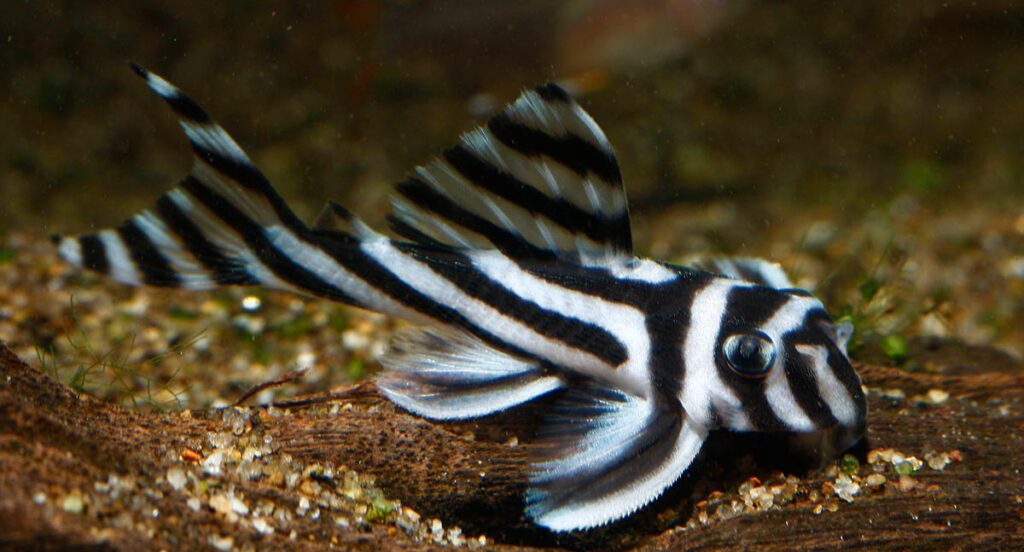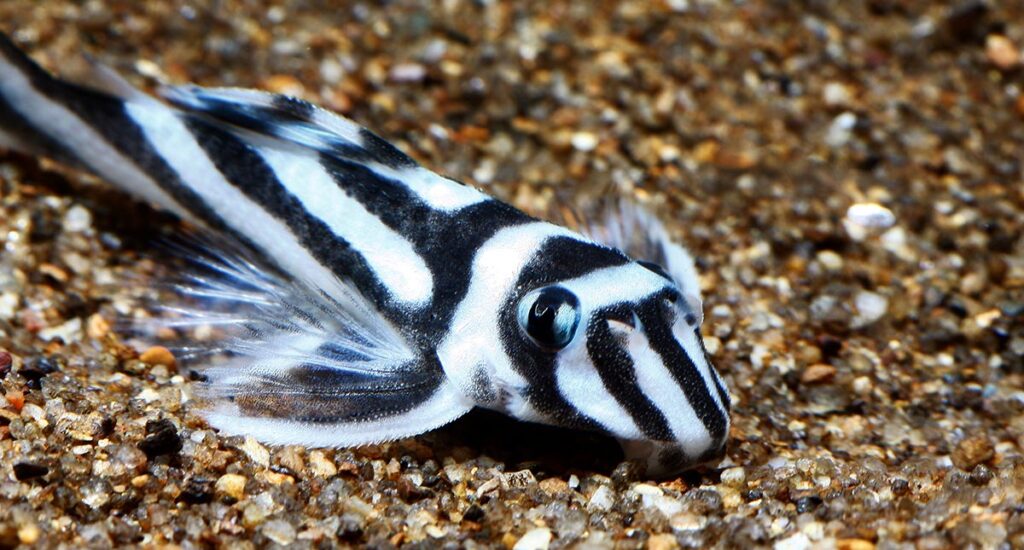
Opinion via National Animal Interest Alliance (NAIA), November 14, 2022
NAIA Editor’s note: the 19th CITES meeting is being held in Panama City right now through November 25th. We are incredibly fortunate to be formally represented by this article’s author, Art Parola at the meeting!
CITES, the Convention on International Trade in Endangered Species of Wild Fauna and Flora, is an international agreement between governments that aims to ensure that international trade in specimens of wild animals and plants does not threaten the survival of the species.
Hypancistrus zebra, better known as the zebra pleco or L-46, is an attractive black-and-white striped Loricariid suckermouth catfish endemic to the Rio Xingu basin in Brazil. It is a well-known and highly sought-after species in the aquarium market and was first discovered and exported from Brazil in 1987. Despite a ban on collection, possession, and export by the Brazilian government in 2004, zebra plecos have continued to be a popular aquarium fish, supplied mainly by commercial captive-breeding of the species in Asia, Europe, and North America. Due to the value of the fish and the demand for employment opportunities in its native range, some illicit collecting and smuggling of the fish also occurs. The vast majority of illegally exported zebra plecos are traded to Asia. A study on demand for the species showed aquarium hobbyists overwhelmingly prefer captive-bred individuals over their wild-caught counterparts. Despite the species’ proven suitability for large-scale aquaculture, and the success of commercial zebra pleco culture operations outside the species’ native range, Brazilian law does not make exceptions for captive breeding. This deprives Brazilians of a legal and sustainable livelihood, thus creating a strong incentive for the illicit fishing and smuggling of the species to continue.
CITES (Convention on the International Trade in Endangered Species) is a UN environmental and trade treaty comprised of 184 signatory nations which provides an international framework for regulating international trade in species threatened with extinction. CITES is a legally binding instrument for achieving conservation and sustainable use objectives to achieve the stated purpose of ensuring that wild flora and fauna are not exploited unsustainably. The Treaty’s member countries meet every 2-3 years for a Conference of the Parties (CoP) to present and vote on proposals for amendments to the Treaty and proposals to add species to, subtract species from, and move species between the CITES appendices.
The 19th CoP occurs November 14-26, 2022, in Panama City, Panama. At this CoP, the government of Brazil has submitted a proposal to uplist H. zebra from the least restrictive CITES listing on Appendix III, to Appendix I, which is the most restrictive CITES listing.
The Treaty operates through three appendices. Each appendix has a level of regulation and list of species to which those regulations apply. Generally, international trade for commercial purposes is banned in Appendix I species as they are considered threatened with extinction in the wild. However, individuals of Appendix I species may be considered as Appendix II listed species if the traded animals or plants come from a CITES-approved breeding facility and meet other specific requirements related to traceability, proof that the breeding founder stock was legally acquired, and that such activities are non-detrimental to wild populations of the species.
Trade in Appendix II species is allowed within certain specifications. Appendix II species are not necessarily threatened with extinction but are species for which trade must be controlled to avoid their becoming threatened with extinction in the future. Appendix II species require export permits from source countries and may be subject to quotas and other trade stipulations. The European Union also requires import permits for Appendix II species. Around 97 percent of CITES listings are Appendix II species. Listings and changes to listing of species between Appendix I and Appendix II are decided by voting at the Conference of Parties, held approximately every two years.
Appendix III listings are species for which a country is asking Parties to help with the species’ protection. Trade in Appendix III species is permitted but is carefully monitored and regulated.
In addition to Conferences of the Parties (CoP), CITES is implemented through three committees: 1) Standing Committee, 2) Animals Committee, and 3) Plants Committee.
Legal Enforcement of CITES
Enforcement of the Treaty is the responsibility of the CITES authority in each member country. In the United States, participation in CITES is codified under the Endangered Species Act (ESA). The CITES provisions of ESA prohibit violations of the Convention (16 U.S.C. § 1538.) and stipulate civil and criminal penalties for violation of CITES that are the same as those listed as threatened or endangered under the US Endangered Species list (16 U.S.C. § 1540). Violations of the Convention are also violations of the Lacey Act (16 U.S.C. §§ 3371-3378), which can elevate any violation of federal, state, tribal, or foreign wildlife law or treaty to a federal felony.
As in much of the world, the reasons behind regulations regarding the aquarium fish trade in Brazil are complex and often somewhat incoherent due to promulgation through multiple iterations with inconsistent and competing philosophies jumbled into the law. Brazil’s regulation of the wildlife trade, while almost always advertised as motivated by conservation, is often based on an economically protectionist policy. There is also an outsized influence by some Brazilian academics who desire to monopolize scientific research of the country’s native species. Unfortunately, in many instances, the resulting law comes at the cost of the livelihoods of locals, is a windfall for black-market enterprises, and has little conservation value.

The Impact of a Listing Change
Not only does H. zebra not meet the criteria for listing under Appendix I, but such a listing will do little to promote conservation of the species in the wild. The listing will, however, significantly impact the ability of commercial aquaculture companies to meet demand for the species. CITES Appendix I listing is incredibly restrictive. Species listed on Appendix I are banned from almost all international trade for commercial purposes. There are exceptions made for individuals produced at CITES-certified facilities. Unfortunately for a species such as the Zebra Pleco, getting CITES certification for a captive breeding operation will be arduous and difficult, and may not even be possible. Such certifications require a nondetriment finding studies, proof of legal acquisition, and traceability requirements that may not be possible to achieve.
A study published in 2021 in the journal Global Ecology and Conservation analyzed the trade and conservation status of the Zebra Pleco. The study recommended three main actions to improve the conservation of the species:
- strengthening enforcement of existing laws in both Brazil and importing countries
- regulation of aquaculture
- an emphasis on regulatory and operational capacity building to develop the commercial culture of the species in Brazil, decreasing the incentive for illicit fishing by providing an alternative sustainable livelihood to fishermen, and further promoting consumers’ support for conservation efforts by purchasing captive-bred specimens.
Brazil’s proposal to uplist H. zebra to CITES appendix I is unwarranted and shortsighted. Even the CITES Secretariat has recommended the proposal be rejected, stating the species does not meet the biological criteria for Appendix I listing. Despite the installation of a dam that has altered the habitat, the species is not rare in that habitat, Brazil’s proposal itself states this fact. H. zebra spawn year-round in the wild. Many of the fish confiscated from smuggling attempts are juveniles, proving the fish are still quite successfully reproducing. The majority of the international trade is in captive-bred specimens. While the proposal stated Brazil predicts a severe population decline over the next 10 years, the proposal offered no evidence to support this conclusion. A recommendation by the CITES Secretariat for rejection of a proposal means a species falls extraordinarily short of meeting the criteria where the listing is necessary for the conservation of the species. The CITES Secretariat applies the precautionary principle liberally. Therefore, when there is any legitimate evidence at all that a species may possibly meet the listing criteria, the Secretariat generally recommends approving the proposal. Exceedingly few proposals are recommended to be rejected.
Captive Stocks are Far Removed From the Wild
The current breeding stock for most captive breeding operations is several generations removed from the original stock exported between 1987 and 2004. It is also likely the lines are now being bred by a person or company who was not the original importer of the founding breeding stock. As such, the export or import documents issued 20 years or more ago are unlikely to still be available.
Even if original documents still exist, the species was undescribed when originally exported, and even after its description in 1991, continued to be traded as Peckoltia sp. “zebra” until Brazil banned export of the species in 2004. In the unlikely event the documents of original, legal import are able to be located, the documents are not likely to list the current valid name of the species. It is also questionable as to whether Brazil would be willing to assist in helping any foreign facility adequately prove legal acquisition or complete a nondetriment finding.
Brazil itself has shown no interest in supporting or allowing aquaculture of H. zebra in its native country. In the listing proposal, Brazil stated it has no legal mechanism to allow banned species to be captive-bred. The government of Brazil cited the 2021 study published in Global Ecology and Conservation as well as the primary author in the listing proposal, but has not appeared to heed the recommendations of the study.
While current illicit collection levels do not appear to be a primary threat to the species, it is possible an increase in demand could change this. If the species is listed under Appendix I, Demand is not likely to decrease. However, supply, currently consisting mainly of captive-bred specimens of H. zebra, will be severely limited, causing the price to rise steeply and making illicit fishing and smuggling a more lucrative, and thus more attractive, business. Given that trade in H. zebra is already monitored and regulated by CITES under Appendix III, trade in the species is already banned in Brazil, and the European Union specifically regulates the species in its jurisdiction, there is no reason to believe enforcement will be any more effective than it is currently. Illicit fishing and smuggling of wild fish is likely to increase significantly to meet demand no longer filled by what will almost surely be a significantly-reduced legal supply of captive bred zebra plecos.
Too little regulation can result in loss of populations, which is not only detrimental to biodiversity, but also for people who rely on those species for their livelihoods. However, the consequences of ineffective regulation can be just as deleterious, resulting in people engaging in alternative forms of resource use that may not directly harvest a species, but may have devastating impacts on habitat. Additionally, the increased cost of legal avenues of trade associated with broad, overly restrictive regulation can make illegal activity more profitable, risking actually increasing unsustainable illicit trade. This is especially true for species like Zebra Plecos which are already in high demand, but currently have a legitimate legal and sustainable source that may be significantly reduced by overly burdensome restrictions on legal trade.
The NAIA will be present at CITES CoP 2021 as an official NGO Observer. There, NAIA will advocate for the sustainable use of wildlife resources. During the CoP, maintaining and expanding a sustainable and legal trade in captive-bred Zebra Plecos will be just one of several key issues NAIA will work to promote. NAIA will encourage CITES delegations to implement effective regulation across the board that empowers people to simultaneously support livelihoods and development and conserve nature and natural resources. You can support NAIA’s important work here.
About the Author

Art Parola developed a love of nature from a young age, spending as much time as he could, covered in mud and creek water, with a butterfly net chasing every critter that crawled, slithered, or swam and trying to identify them with his collection of field guides. This led him to a career path focused on animal welfare, sustainable development, and conserving nature, particularly through sustainable use policy initiatives. He is currently a consultant while pursuing a law degree. He still hasn’t lost his childhood enthusiasm for spending time in nature, although he now more commonly carries a camera instead of a net. His writing and photographs have appeared in numerous online articles, as well as in print publications in multiple countries around the world.





